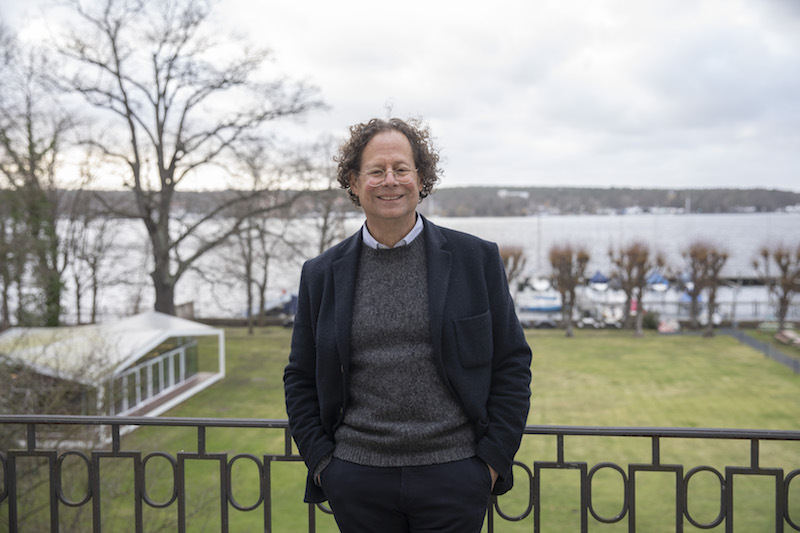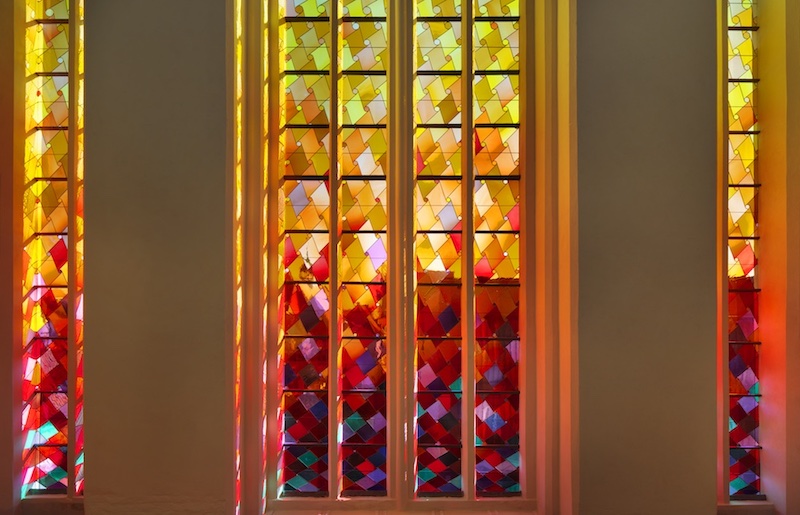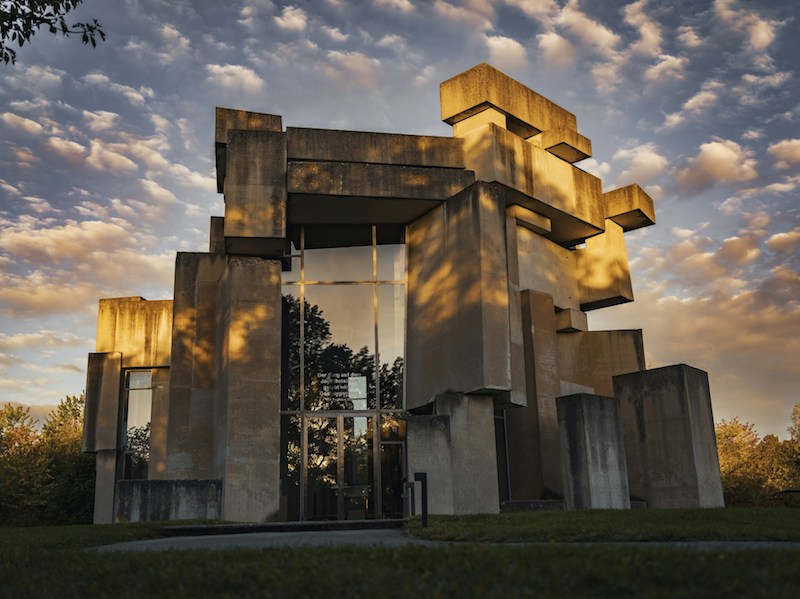by Annalisa Giacinti // June 18, 2024
After 20 years of tenure, Adam Weinberg stepped down as director of the Whitney Museum in the fall of 2023. Among the many other roles and appointments he currently juggles, he was assigned the Presidential Fellowship at the American Academy in Berlin—which just celebrated its 25th anniversary—for the Spring 2024 semester. Here, alongside working on a new book and giving lectures, Weinberg is rekindling his passion for contemporary art. Together, we talked about the joy of going on studio visits, his research into artist chapels and sacred spaces and the importance of finding moments to pause and reflect.

Adam Weinberg, portrait // Photo by Annette Hornischer, courtesy of American Academy in Berlin
Annalisa Giacinti: In your lecture on Abstract Expressionism at the American Academy, you said that after 40 something years of a museum career, you’re finally enjoying a reset here in Berlin and renewing your connection to art. Could you tell us about this readjustment, and the opportunities that this residency has brought to you to reconnect to art?
Adam Weinberg: Museum directors in the United States have a rather different role than museum directors in Germany. Most museums in the US are private museums, and are not funded to any large extent by the government. This means, raising money constitutes at least 50% of the job. In addition, a lot of time goes into management, and dealing with all kinds of people and challenges.
I started as a curator and worked as a curator for many years. When I became a museum director, little by little I did less and less with the art; my role was primarily the overall formation of the program, as opposed to actually working on the program itself. And, after 20 years as the director of the Whitney Museum, and having curated only one exhibition during that time, I am now back to curating, writing, researching, reading and giving lectures. I’m also doing some strategic advising for museum directors internationally.
For me, this is a chance to return—after 45 years in the field—to the reason that I started in museums to begin with, and that’s the art and the artists of our time.
AG: In another interview you compared the role of a museum director to that of an orchestra conductor, who curates and oversees a whole array of artists and curators. Now, it seems, your work has shifted to a more individual approach.
AW: It’s been really wonderful. I’m a New Yorker, and I worked in New York. There, even though there are many artists, the dominant force in the art world is the market. And if you go to Paris, the dominant aspect of the field is the museums. While in Berlin, the dominant aspect of the field is artists, which has been a great joy for me; since I came here I’ve been going to about two studio visits every week. There’s nothing like being in an artist studio to rekindle your excitement about art, to talk about the making, the ideas, to see things in process; to get your finger on the pulse, the heartbeat of what’s going on.
I have visited young artists like Dan Lie, who has a residency at Callie’s, and they have a very nice show at Barbara Wien right now. Then I was briefly at Gropius Bau the other day, I went to meet the new director Jenny Schlenzka. She took me to see Kerstin Brätsch’s work. She’s doing a residency there and I went to see her incredible new paintings. This is an artist who has shown at the Whitney before, but I hadn’t seen her in many years, and it was fantastic to spend even a half hour with her. Then the next day, I went to see the Scottish, Berlin-based artist named Susan Philipsz, who does amazing sound works. She’s an internationally known artist, but we had only met in passing.

Olafur Eliasson: ‘Fenster für bewegtes Licht (Window for moving light),’ 2024, during installation in the east windows of St. Nicholas’s Cathedral, in Greifswald // Photo by Jens Ziehe, courtesy of the artist
AG: Can you tell us a bit about your current research project?
AW: I’m working on a book regarding contemporary artist chapels and sacred spaces. This came about for a couple of reasons: most importantly, over the last years I had been visiting a number of spaces that were designed by artists as places of meditation, contemplation and spiritual significance, though not necessarily religious. I realized it was a growing and important genre of artistic production. For example, in Berlin alone, I experienced the wonderful James Turrell chapel here in the Dorotheenstädtischer cemetery. Another one of the impressive installations I saw here, that will very likely be in my book, is the Reflection and Prayer Room by Günther Uecker, in the Reichstag. And then last week, I went to see Olafur Eliasson, the Danish/ Icelandic artist, based here in Berlin, who just completed a chapel in Greifswald, which is the hometown of Caspar David Friedrich. I was also recently in Austria, outside of Vienna, where there’s an amazing chapel by Wotruba, one of the most famous Austrian post-war minimalists. And so I have been looking at examples of these chapels in Germany and neighboring countries.
My interest has really been about the Gesamtkunstwerk, and the idea of how historically the artist chapel—and I will mention Giotto’s Scrovegni Chapel in Padua or the Sistine Chapel—was considered the peak of what an artist could do, the idea of making a total space, a total work of art that in theory would last forever. And, in the post-war period, this becomes married to installation art—the idea of modernism moving beyond the frame—and more recently the idea of the immersive artwork. This book looks at artists’ chapels and sacred spaces, mostly from 1950s to the present, although there are some examples from the 1920s and 30s.
When I say chapel, it could be Islamic, it could be Jewish, it could be Quaker, it could be Shinto or non-denominational. The idea is a space that’s not so much about narrative, historically the way that chapels have been about telling stories through iconography; it’s really about the experience first.
AG: How did you pick the artists you wanted to include in the book?
AW: I started the project three years ago and I have now found over 100 examples. So the first thing I’ve been doing is researching and surveying the subject globally. Most of these chapels—by artists, not architects—are in Europe, in the US, but there are some in Africa, some in Latin America and some in Asia. And the idea is to select somewhere between 30 and 40 prime and varied examples. This will be the first book that I know of that’s a treatment on the subject, and the hope is also to turn it into a small television series.
AG: Which artists caught your attention the most from the ones you researched for the book?
AW: The artist Wotruba was a real surprise. He is one of the most prominent Austrian modernists, and I had never heard of him before, yet I think he has produced one of the most important projects to be featured in my book. The artist Sol LeWitt created an amazing synagogue in New England, based on 18th and 19th century Polish wooden synagogues—all of which were destroyed during the war—and realizes it using traditional American post and beam architecture. Louise Bourgeois transformed a small, medieval, stone chapel in the south of France. And the Uecker chapel at the Reichstag is very interesting to me: the idea that this site-specific space was created at the heart of the German government, next door to the Bundestag, for the members of the government and the people who work in the building is astonishing and touching. It’s a non-denominational chapel, it nods to Christianity but is not intended to be a Christian chapel. There were also quite a number of very interesting temporary chapels in this year’s Venice Biennale. It’s in the air right now, the idea of artists creating spaces of contemplation, release, hope and dreams.

Wotruba church // Photo by Michael Pointner on Unsplash
AG: Why do you think artists are turning to spiritual places right now?
AW: I think right now the world is a mess. There are a lot of people who are interested in retreating from the craziness of contemporary culture with all its challenges and ills. We’re in a time when people don’t reflect, they don’t listen and they don’t think deeply, they react. So many of us just respond—on our screens, on our phones, with little knowledge and no nuance. It’s a culture of response without call. I think that there is a tendency for a lot of artists to want to create places, environments and situations that in effect say: “How can we bring something to the world that actually causes people to reflect and to listen, to ourselves and others?”
AG: After your residency at the American Academy ends, what’s next?
AW: I’m going to Italy to work on an exhibition of a wonderful painter named Isabella Ducrot, who lives in Rome. She’s 92 years old, from Naples. The exhibition will be at the MADRE Museum in Naples and will be her first ever retrospective, and in her hometown no less. I’m also working on a small exhibition in Athens, on the German-American artist, Charline von Heyl, who is one of the great painters of her generation.
And then I have to spend time visiting the remainder of the chapels and sacred spaces and actually get to work on the writing of my book, if I’m ever going to get it done!






















